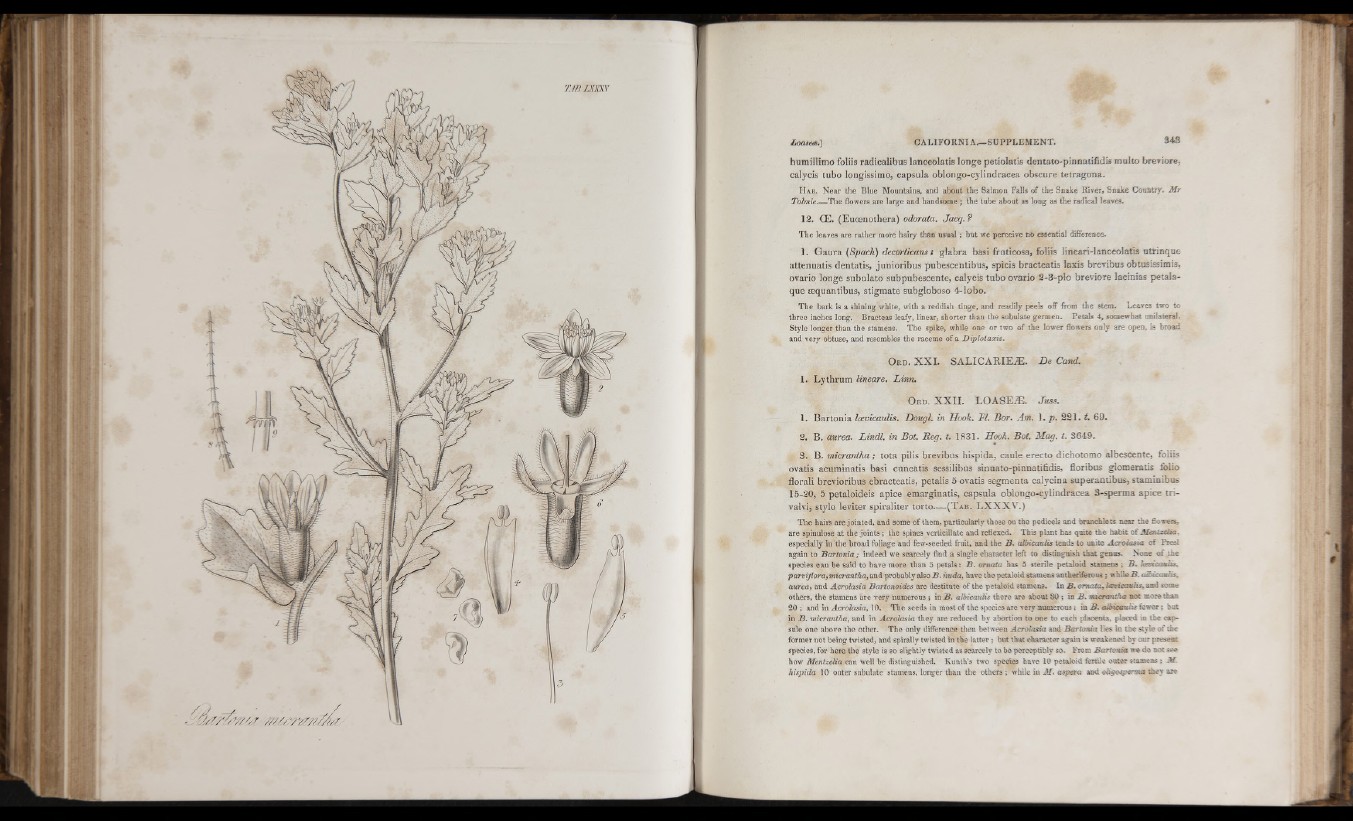
f
humilUmo foliis radicalibus lanceolatis longe petiolatis dentato-pinnatifidis m olto breviore,
calycis tubo longissimo, capsula oblongo-cylindracea obscure tetragona.
H ab . Near the Blue Mountams. and about the Salmon Falls o f the Snake River, Snake Country. Mr
Tolmie The flowers are large and handsome ; the tube about as long as the radical leaves.
12. OE . (Eucenothera) odorata. Jacq.?
The leaves are rather more hairy than usual ; but wc perceive nò essential difference.
1. Gauva [Spach) decorticans; glabra basi fruticosa, foliis lineari-lanceolatis u trin q u e
a ttenuatis dentatis, ju n io rib u s pubescentibus, spicis bracteatis laxis brevibus obtusissimis,
ovario longe subulato subpubescente, calycis tubo ovario 2-3-plo breviore lacinias petala-
que æquantibus, stigmate subgloboso 4-lobo.
The bark is a shining white, with a reddish tinge, and readily peels off from the stem. Leaves two to
three inches long. Bracteas leafy, linear, shorter than the subulate germen. Petals 4, somewhat unilateral.
Style longer than the stamens. The spike, while one or two of the lower flowers only are open, is broad
and very obtuse, and resembles the raceme of a Diploiaxis.
O r d . X X L S A L IC A R IEÆ . D e Cand.
1. L y th rum /in e a re . Linn.
O r d . X X I I . L O A S EÆ . Juss.
1. Bartonia lævicaulis. Dougl. in Hook. FL Bor. Am. Ì. p . 2 21. t. 69.
2. B. aurea. Lin d l. in Bot. Reg. t. 1831. Hook. Bot. Mag. t. 3649.
3 . B. micrantha ; to ta pilis brevibus hispida, caule erecto dichotomo albescente, tbliis
ovatis acuminatis basi cuneatis sessilibus sinuato-pinnatifidis, floribus glomeratis folio
florali brevioribus ebracteatis, petalis 5 ovatis segmenta calycina sup eran tib u s, staminibus
15-20, 5 petaloideis apice emarginatis, capsula oblongo-cylindracea 3-sperma apice trivalvi,
stylo leviter spiraliter to rto— (T ab. L X X X V .)
The hairs are jointed, and some of them, particularly those ou the pedicels and teanchlets near the flowers,
are spinulose at the joints ; the spines verticillate and refiexed. This plant has quite the habit of Mentzeha.
especially in tlie broad foliage and few-seeded fruit, and tbe B . albicatdis tends to unite Acroiofia of Presi
again to Bartonia ; indeed we scarcely find a single character left to distinguish that genus. Noue of the
species can be said to have more than 5 petals : B . ornata has 5 sterile petaloid stamens ; B . lancauhs,
parviflora, micrantha, and probably also B . nuda, have the petaloid stamens antheriferous ; while .S. aSncamlâ,
aurea, and Acrolasia Bartonoides are destitute of the petaloid stamens. In B . ornata, heviaxuiis, aini sotae
others, the stamens are very mimerous ; in B . albicaulis there are about 80 ; in B. m c n a u h a not more than
20 ; and in Acivlasia, 10. The seeds in most of the species are very numerous ; in B . aibiceniis fewer ; but
in B . micrantha, and in Acrolasia they are reduced by abortion to one to each placenta, placed in the capsule
one above tho other. The only difference then between Acrolasia and Bartonia lies in the style of the
former not being twisted, and spirally twisted in the latter ; but that character ^ a in is weakened by our prese«
species, for here the style is so slightly twisted as scarcely to be perceptibly so. From Bartonia we do not see
how Mentzelia can well be distinguished. Kunth’s two specie have 10 {,>ehiJoid fertile outer stameas : i\£.
hispida 10 outer subulate stamens, longer than the others ; while iu M . aspera and oligosperma they are